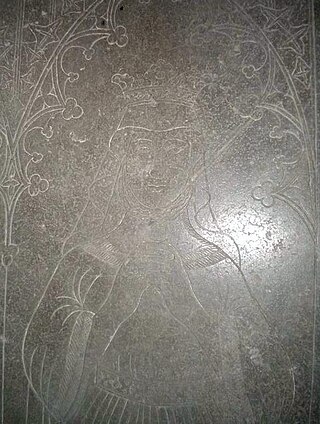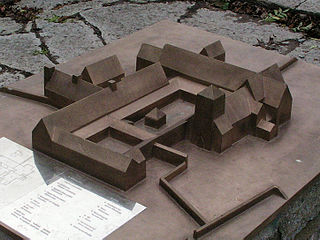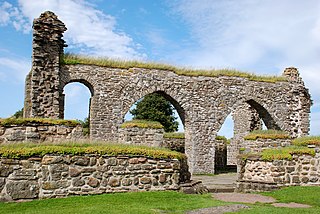Related Research Articles

Princess Ingeborg of Denmark, was a Princess of Sweden by marriage to Prince Carl, Duke of Västergötland.

Knut Långe, also known as Canute II, was King of Sweden from 1229 until his death in 1234. He was the father of Holmger Knutsson, a later pretender for the Swedish throne. Both father and son were members of the House of Folkung. He is often identified with Knut Holmgersson, a relative of King Erik Eriksson.
Richeza of Poland, a member of the House of Piast, was twice Queen of Sweden and once Princess of Minsk through her three marriages. Tradition describes her as unusually beautiful.
Sverker the Younger, also known as Sverker II or Sverker Karlsson, was King of Sweden from 1195 or 1196 to 1208 when he was defeated in the Battle of Lena by Erik Knutsson. Sverker died in the 1210 Battle of Gestilren where his forces battled those of King Erik Knutsson.
Magnus Minniskiöld was a medieval Swedish magnate from the House of Bjälbo. He is best known as the father of the renowned statesman Birger Jarl, and the ancestor of the later Swedish kings. He is sometimes believed to have perished in the Battle of Lena in 1208, though the evidence is not conclusive.

Kol was a Swedish prince who, together with his brother Burislev was a contender for the throne of Sweden from 1167 until his violent death a few years later. The struggle was a stage in the rivalry between the House of Sverker, to which Kol and Burislev belonged, and the House of Eric.
Boleslaw was a Swedish pretender for the throne, belonging to the House of Sverker. He acted in concert with his kinsman Kol against King Canute I of Sweden, then head of the House of Eric. The two pretenders, who were brothers, half-brothers, or uncle and nephew, may never have controlled much more than the Province of Östergötland, which was the base of the dynasty. Boleslaw is believed either to have been murdered by King Canute's men, or to have fled to Poland in or before 1173.

Julita Abbey was a monastery of the Cistercian monks in the parish of Julita in Oppunda Hundred, Södermanland, Sweden.
Svantepolk Knutsson was a Swedish knight and councilor. He became a wealthy feudal lord in Östergötland.

Catherine Sunesdotter, was Queen of Sweden from 1244 to 1250 as the wife of King Erik Eriksson. In her later years she served as abbess of Gudhem Abbey in Falbygden.

Rikissa of Denmark was Queen of Sweden as the wife of King Erik Knutsson, and the mother of King Erik Eriksson.
Helena or Elin, possibly also known as Maer, Mär or Mö, was Queen of Sweden as the wife of King Inge the Elder, and a supposed sister of King Blot-Sweyn of Sweden.

Helen of Sweden was a Swedish princess and daughter of King Sverker II of Sweden. She was the mother of Queen Catherine of Sweden. She was later Abbess of Vreta Abbey.
The three abductions of maidens from the Vreta convent was a series of events that took place in Sweden in the 13th century. They became legendary and inspired many poems.

Vreta Abbey, in operation from the beginning of the 12th century to 1582, was the first nunnery in Sweden, initially Benedictine and later Cistercian, and one of the oldest in Scandinavia. It was located in the present-day municipality of Linköping in Östergötland.
Cecilia Johansdotter is the possible name of the wife of King Canute I of Sweden and mother of King Eric X of Sweden. Little is known about her except that she was of aristocratic origins and died sometime after 1193.

Gudhem Abbey is the ruin of a nunnery which was in operation from 1152 to 1529. It is located in Gudhem outside Falköping in the Falbygden area in Västergötland, Sweden. It was initially part of the Benedictine and later Cistercian order. It is considered to have been one of the oldest convents in Sweden; after Vreta Abbey (1100) and Alvastra Abbey (1143).
Ingrid Svantepolksdotter, was a Swedish noble and abbess. She is foremost known for being the central figure in one of the famous incidents referred to as the Maiden Abduction from Vreta, where she, like her mother before her, was abducted from Vreta Abbey by the man she later married. Later in life, she became an abbess at the very same abbey, in which position she served in 1323–1344.

Skänninge Abbey, also known as St. Ingrid's Priory, was a convent for Dominican nuns in Skänninge in Sweden which existed from 1272 until 1544. It was founded by Ingrid of Skänninge, and as such, it was often referred to as St. Ingrid's Priory. Located near the church dedicated to Martin of Tours, it was originally named St. Martin's Priory, though this name was rarely used. The common name for it was Skänninge Abbey, but as there was also a convent for Dominican friars in Skänninge, it was often called Skänninge Nunnery.
References
- ↑ "Helena". Svenskt biografiskt lexikon. Retrieved April 1, 2020.
- ↑ "Vreta kloster". Wikisource. Retrieved April 1, 2020.
- ↑ "Sune Folkesson". Svenskt biografiskt lexikon. Retrieved April 1, 2020.
- ↑ "Katarina". Svenskt biografiskt lexikon. Retrieved April 1, 2020.
- ↑ Hans Gillingstam. "Lars Petersson". Svenskt biografiskt lexikon. Retrieved April 1, 2020.
- ↑ Roger Axelsson. "Svantepolk Knutsson". Svenskt biografiskt lexikon. Retrieved April 1, 2020.